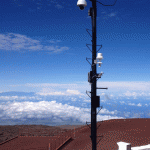Some parts of the job are simply fun. Installing the various upgrades to the weather system has been just that. The latest piece of kit being more fun than usual.

Even that is topped by the camera I installed this fall. The latest camera is a new pan-tilt-zoom camera attached to the weather mast.
The camera does have more prosaic reasons to justify the effort of installing it. With the camera the operators can observe the weather conditions around the telescope, observing supervisors can view the ice and snow on the domes from Waimea, the day crew can check the weather conditions before driving to the summit, and more. The camera does have enough sensitivity to see the brighter stars and the banks of fog that roll over the summit. In full dark and at full gain the image is noisy and faint, not all that great. Given just a little moonlight the performance is much better, allowing visibility of oncoming clouds.

Even more fun! On Christmas Eve I was contacted by Hawaii News Now for photos of the storm, they were eager to do something about a white Christmas for the evening news. As I had not been to the summit and no one on our crew was up, I simply grabbed some MastCam images and forwarded them. The images were aired in the first couple minutes of the Honolulu evening news!
The camera is not available to the public, it would be too much wear and tear to the pan-tilt mechanism and a huge hog of bandwidth. You have to be inside the Keck network to use, from there it is available to anyone on staff. It has proven quite popular, with many folks using the imagery to check on mountain conditions in the latest bad weather.
Next up, yet more cameras in the dome and even a couple on top of the domes. there is also a precipitation sensor and more in the works for the weather station.
OK, enough fun, back to revising the Keck 2 dome schematics.



